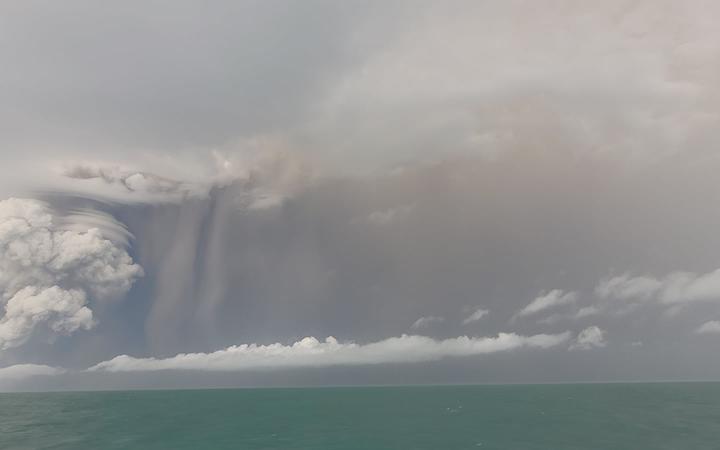There has been little contact with Tonga since an underwater volcano, Hunga-Tonga-Hunga-Ha’apai, erupted early yesterday evening.
A tsunami hit the Kingdom after the volcano erupted for eight minutes, throwing clouds of ash into the sky.
Waves flooded the capital, Nuku’alofa, where video footage has shown water engulfing buildings.
Communications with Tonga has been down since 6.30pm yesterday, with reports that power had been cut in the capital.
Tongan authorities should have a clearer picture this morning of the scale of the damage from Saturday’s volcanic eruption and tsunami.
The New Zealand defence force is currently monitoring the situation in Tonga, and said it stands ready to assist if requested by the Tongan Government.
 Hunga-Tonga-Hunga-Ha’apai on Friday, January 15, 2022 Photo: Tonga Geological Services
Hunga-Tonga-Hunga-Ha’apai on Friday, January 15, 2022 Photo: Tonga Geological ServicesOne-in-1000-year event, according to volcanologist
Scientists are predicting that Tonga’s main island, Tongatapu, could be blanketed in ash this morning.
An Auckland University volcanologist, Shane Cronin, said the magma type erupted by Hunga-Tonga-Hunga-Ha’apai is called an ‘intermediate composition’ – similar to what comes from the Ruapehu volcano.
It was not especially rich in volatiles such as sulphur or fluorine, and as a result, this volcanic ash was not especially toxic.
However, he said, all volcanic ash could produce acid rain.
“Help will be needed to restore drinking water supplies.”
Otago University geologist Marco Brenna estimated that Tonga’s main island, Tongatapu, will be blanketed with a few millimetres to a few centimetres of ash today.
 Tonga’s Geological Services went out to the site on Friday, January 15, 2022 Photo: Tonga Geological Services
Tonga’s Geological Services went out to the site on Friday, January 15, 2022 Photo: Tonga Geological Services
Dr Cronin said the Hunga eruption was a one-in-1000-year event.
Radiocarbon dating suggested one major eruption of this scale occurred about AD1100 and another in AD200, he said.
“This, along with other data from the volcanic ash records, suggests a recurrence interval of 900 to 1000 years for very large eruptions at the volcano.
“The current eruption seems to be one of these large events which fits with the timing since the last of these in [circa] AD1100.”
